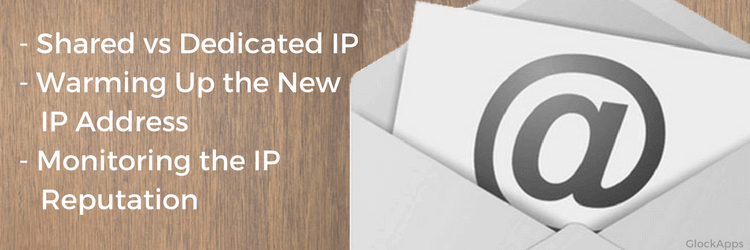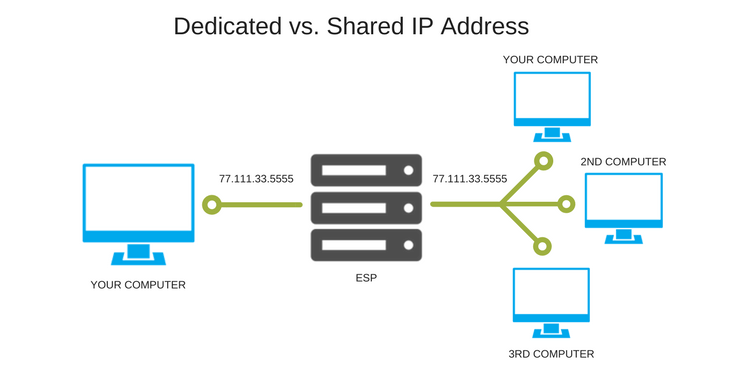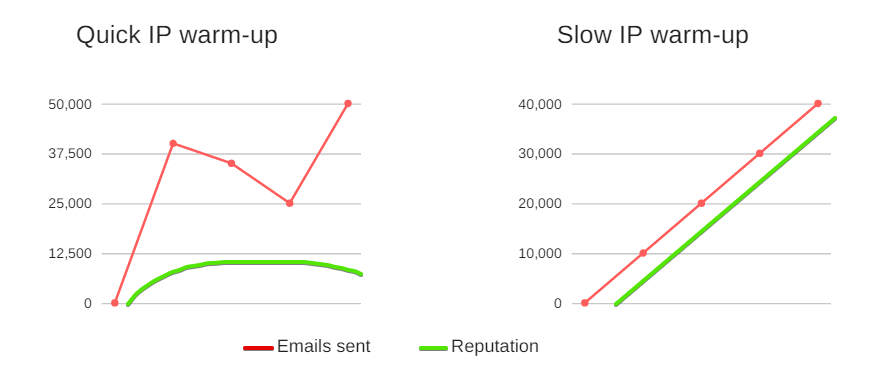Dedicated vs Shared IPs: Which Should You Choose for Better Deliverability

When you hit “Send” in your email system or email service provider, your email is transmitted to the outgoing mail server and then to the mail server at the receiving ISP, which then decides what to do with your email based on the sending IP’s reputation, authentication, your sending practices, and recipient engagement.
These factors directly influence whether or not your email will be delivered and where it will land (Inbox, Spam, Promotions).
To help you keep the technical aspect of your email program in order, we’re going to focus on the sending IP address as one of the most important elements of your sending infrastructure:
1. Shared vs Dedicated IP: Choose for Your Needs.
In email marketing, the IP address allows ISPs to identify the mail server sending emails.
When it comes to email sending, you can use a shared IP, a dedicated IP, or a pool of dedicated IP addresses.
What is a Shared IP?
The shared IP environment is a number of IP addresses used by one organization or a group of unrelated organizations to send emails. Such group of IP addresses is also called the “shared IP pool.” The shared IP pool is used by most email service providers. Shared IPs are typically used to handle email delivery of multiple low-volume senders or irregular senders.
Shared IP address advantages are:
- Inexpensiveness. Shared IPs are much cheaper than dedicated ones due to the amount of senders using the same service.
- Gives an opportunity to develop an IP reputation even if you send low volumes of emails.
The downside of using a shared IP is that it limits your ability to influence the IP reputation and puts you in dependence on the sending practices of your IP neighbors.
Being on a shared IP means a weaker deliverability for the best senders and better deliverability for low-quality senders. The good news is that email service providers are now extremely skilled at identifying and blocking abusive senders, and even predicting bad behaviors before they do harm.
What is a Dedicated IP?
A dedicated IP address is what exactly it sounds — an IP exclusively dedicated to you or your organization.
Dedicated IP address advantages are:
- Full control over the mail sent from the IP. The receiving ISPs build the most accurate opinion about your sending practices because only you influence your reputation.
- Opportunity to avoid a sender appendix like mydomain.myesp.com associated with your emails. This appendix is added in the shared IP pool but not with dedicated IPs.
- Simplified troubleshooting process: dedicated IP gives an opportunity to identify core IP reputation problems.
When should you consider a dedicated IP?
There is no strict recommendation, but if your sending consistency is strong and you send 50-100k emails per week or more, you can consider switching to a dedicated IP.
Although a dedicated IP allows you to have the full control over your emails sent and reputation, there is a misbelief that other senders cannot impact your deliverability. But they can.
The truth is that if senders with a bad reputation use dedicated IPs from your IP range, then it’s possible that if an ISP sees bad behavior in that IP range, they’ll just add the whole IP range to the blocklist.
Read: Can’t Keep up? 9 Ways to Simplify Your Path to the Recipient’s Inbox
The key here is to get a dedicated IP with an email service provider that has a perfect reputation and to not hesitate to ask questions about other senders “near” you and their sending history.
Is it enough to have a single dedicated IP?
If you have multiple different kinds of email programs, some are riskier, others are less, get several dedicated IP addresses. At a minimum, it is recommended that you split your transactional and marketing mail streams into two separate IPs. If you are a beginner and don’t have a very complicated email program, start with one IP.
If you are a large sender, estimate the max volume of emails you send per hour and consider the hourly limits per IP imposed by your email service provider. Thus, you’ll know how many IPs are required to fulfill your needs.

2. Warming Up the New IP Address: Helps Build Your Sender Reputation.
What is Sender Reputation?
Sender reputation is a reputation of your IP. It helps receiving servers decide whether you are a spammer or not; it determines how the receivers treat you and your emails.
Sender reputation controls access to the Inbox:
Bad reputation -> Spam folder or block
Good reputation -> Inbox
Sender reputation is based on:
Spam complaints
Hard bounces
Spamtrap hits (PDF guide)
Email authentication (SPF, Sender ID, DKIM, DMARC)
IP address
Sending domain
Engagement
In this chapter, we’ll focus on how to build a reputation for your new dedicated IP address.
What is IP Address Warm up?
When you get a new IP, there is no sending history for it and your deliverability can be unpredictable for the first time (e.g. some mailbox providers can place your emails to the Spam folder) because ISPs don’t know anything about your sending practices.
Thus, you have to build the reputation for your new IP address. This process is called “IP warming up” and implies starting sending emails slowly and gradually increasing the volume of emails sent over a designated period to build a positive reputation with Internet Services Providers (ISPs).
ISPs see emails coming from a new IP address as suspicious until it gains a positive sending reputation. The warm-up process takes 4-8 weeks depending on the volume you try to achieve and recipient engagement, but it can take more time if the receiving ISPs don’t consider emails being opt-in.

Some ISPs limit the number of emails senders can deliver to their users until they build a sender reputation. For example, AOL limits emails from new senders to 5,000/day and Outlook – to 20,000/day for the first week.
We recommend starting the warm-up process with the verified data and most active subscribers. It’s important that during your warm-up process you email to the recipients who are less likely to bounce and complain. This segment would include people who have opted-in most recently and who are consistently opening/clicking.
Start sending to your most engaged subscribers and then add other (older and less active) segments as you progress. Add them in parts of 10% to 25% in order not to change your reputation from good to bad.
Read: 9 Questions You Should Be Asking If You Have Deliverability Issues
During the warm-up period the more consistently and frequently you send and the lower your complaint and bounce rates, the faster you will establish a positive sending reputation with ISPs. If you send infrequently, it will take longer to build a positive reputation.
IP Warm-Up Plan
Below is an approximate 7-week scenario you could use to warm up your new dedicated IP:
| Weeks | Limits | Notes |
|---|---|---|
| Week 1 | 20,000/day per ISP Hotmail: 10,000/day Yahoo: 30,000/day AOL: 5,000/day | During the weeks 1-2 send to the most active subscribers (preferably 30 days active). |
| Week 2 | 40,000/day per ISP Yahoo: 60,000/day AOL: 10,000/day | |
| Week 3 | 80,000/day per ISP Yahoo: 120,000/day AOL: 20,000/day | During the weeks 3-4 send to the 60 days active subscribers. |
| Week 4 | 160,000/day per ISP Yahoo: 240,000/day AOL: 40,000/day | |
| Week 5 | 320,000/day per ISP Yahoo: 480,000/day AOL: 80,000/day | During the week 5 keep the percentage of inactive subscribers no more than 25%. |
| Week 6 | 640,000/day per ISP Yahoo: 960,000/day AOL: 160,000/day | Starting from the week 6 you can add older and less active subscribers by 25%/week. Watch your stats and roll back if any deliverability issues arise. |
| Week 7+ | Double the previous week volume each week until the desired sending volume is reached |
How to Warm up an IP Address
Read this 11-page whitepaper to learn why and how to warm up your new IP
and make sure you’re doing it right.
Once you begin warming up your IP you can face some deliverability issues related to spam placements or blocking..
Below are the details of what you can expect and actions to take:
Spam placements at Yahoo, AOL, and Gmail. Typically it is fixed after a few campaigns with solid positive user engagement, but it can take more time to get to the Inbox. The key is to keep sending.
Possible blocking by ISPs. This issue can occur if the subscribers aren’t engaged enough or if you are exceeding those daily limits per ISP. The key is to segment carefully and roll back the volume to the number of the allowed limit for a week with the effected ISP and then begin ramping back up. Again the key is to keep sending.
It is important to monitor your deliverability and email placement at different ISPs during the warm-up phase and adjust the plan if needed.
GlockApps will help you test your deliverability with dozens of popular mailbox providers. The tool will show you where your email is placed at Gmail, Yahoo, AOL, Hotmail, Outlook and other mailbox providers. Thus, you will see if there is an improvement in your deliverability as your warm-up process is progressing.
3. Monitoring the IP Address Reputation: Know Before It’s Too Late.
As you keep the reputation of your dedicated IPs in your hands, it’s important that you are aware of its current state.
Read: How to Improve Delivery to Gmail Inbox
You should do a regular IP blacklist check as blacklists can dramatically impact your deliverability to the Inbox.
You can check whether or not your sending IP addresses are on any of the common blacklists using the GlockApps email tests or an uptime IP blacklist monitor.
If you find your IP blacklisted, see how bad of a blacklist you’re on and whether or not your deliverability problems are caused by the blacklisting issue.
There is a lot of small blacklists that don’t really have a lot of weight. There are real-time blacklists meaning your IP can actually get in and out of a blacklist and don’t stay on it permanently.
And there are major blacklists like Spamhaus. A Spamhaus listing is likely to result in mail being blocked.
So, if your IP is listed in any of major blacklists which hurt your deliverability, it’s recommended that you try to remove your IP from a blacklist.
Mailbox providers are forced to take measures to protect their users from unsolicited emails. Thus, besides public blacklists, your sending IP can be blacklisted by a particular ISP: Gmail, Hotmail, Yahoo or other. IP blacklisting is often the real problem that prevents your emails from reaching target recipients on that particular ISP.
Below are good guides you’ll want to check to learn how to find out if your sending IP is blocked by an ISP and how to request the removal:
How to Remove Your IP Address from Gmail’s Blacklist
How to Remove Your IP Address from the Hotmail/Outlook’s Blacklist
How to Remove Your IP Address from the Yahoo!’s Blacklist
Ways to Improve Your IP Address Reputation
You know what to do if you find yourself on a blacklist, but how to avoid them in the first place? Here are the ground rules for improving IP reputation and avoiding problems in the future:
- Warm up IP
- Keep a healthy mailing list (send only to subscribed recipients, use double opt-ins, delete inactive subscribers);
- Don’t purchase mailing lists;
- Maintain a stable sending frequency;
- Implement authentication records.
Keep reading: Everything Email Marketers Need to Know About Sender Reputation
Closing thoughts:
The key thing to remember is that the easiest way to build a good sender reputation is to not use spamming strategies.
Build a list of confirmed opt-in subscribers, stick to the frequency and content you promised when they signed up, give them a clear way to unsubscribe and honor unsubscribe requests and complaints timely.
If you are a small, inconsistent or infrequent sender with less than 50k emails per month, the typical shared IP pool offered by most top-level email service providers is a great solution.
If you’re consistently sending 50k+ messages per month, a dedicated IP might be worthwhile testing.
For 200k+ messages per month, dedicated IPs are recommended. When purchasing dedicated IPs, choose an ESP that has a good reputation and ask hard questions about other dedicated IP senders in your block.
Take time to warm your sending IPs up and monitor their reputation and deliverability consistently to determine issues before they harm your deliverability.



